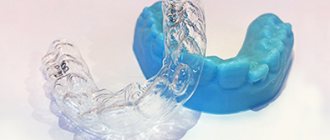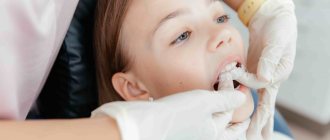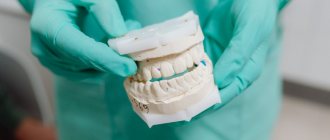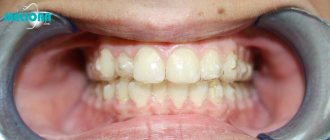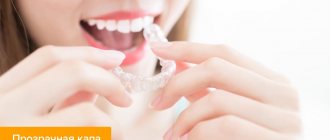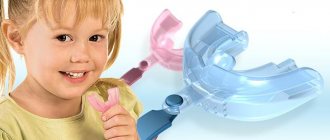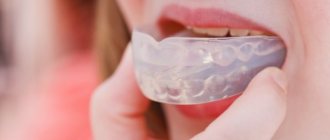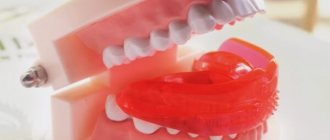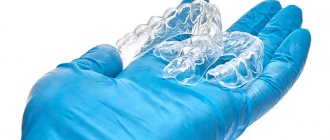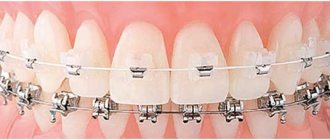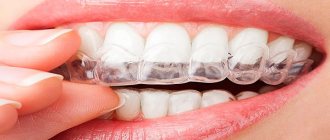A plate for straightening teeth (bracket) looks like a small arch of wire that wraps around the outside of the teeth. This is a removable or non-removable complex orthodontic structure that is installed on the jaw in order to correct aesthetic defects and restore chewing function in case of its impairment or loss.
The device works by applying pressure to the bone tissue. As treatment progresses, the screws will need to be periodically tightened to maintain the therapeutic effect. As a result, in a year or two you can have an attractive, even smile.
What is the name of the teeth straightening plate? The doctor will understand the patient, no matter how he expresses himself. Braces are often confused with retainers, but these designs have slightly different functions.
Indications for use
The device is installed if necessary:
- prevent possible displacement of teeth, keep them in the correct, natural position;
- adjust the shape of the jaw bones or the width of the palate;
- expand interdental distances, get rid of crowding (in children);
- consolidate the result after wearing braces;
- slow down bone growth.
There are also contraindications, but they are few:
- severe mental disorders;
- some respiratory tract disorders;
- allergy to the metal from which the device is made;
- exacerbation of periodontal diseases.
If the oral cavity is not sanitized, there are caries, problems with the gums, the enamel looks bad: before you start wearing a child or adult plate to straighten teeth, you need to get rid of concomitant diseases.
Plates versus braces
The bones of the face are still developing in childhood. So, if deviations in the way the teeth are positioned in a child are detected, it is recommended to install a plate rather than braces. It is not recommended to use braces in childhood.
Important ! Until the child is 12-14 years old, it is recommended to use plates to normalize the bite by fixing the teeth in the correct position. But braces can cause disruption in the development of facial bones.
Another good thing about the plates is that the child can remove them himself to get a little rest. The maximum period of such rest varies from a couple of hours to half a day, which is determined by the severity of the problems.
When is the best time to bet
The device is used both at a young and at a more mature age, depending on the needs of the client. If there are no significant jaw defects and only supportive or consolidating therapy is required, such a design can be used in adult patients, but they are given only non-removable versions - the removable version does not provide sufficient pressure on the formed dentition to keep it in its normal position.
When are plates placed to straighten children’s teeth, how are they made, what are they called and what are they needed for? The optimal option is considered to be 5–6 years old; sometimes the device is installed on children (3–4 years old), but the final decision is made only by the dentist. It is popular to use a lightweight orthodontic device instead of braces in adolescence, up to 12 (less often up to 15–16) years - mainly to correct minor malocclusions and alignment problems.
In adulthood, dental correction is performed using more complex systems or aligners, but there are cases when the use of arches is prescribed for adults.
A little about why the bite can form incorrectly and how to avoid it:
Plates for teeth straightening
Orthodontic plates are often called “braces” or “plates on the teeth.” This device is used to treat children under 15 years of age. Made individually for each child. It is attached to the outer surface, the inner part and can partially cover the sky. Made from soft or medium hard plastic and metal. The child takes food without any discomfort. There is no need for any special care for the plates.
Purpose:
- abnormal development of the bones of the jaw arches (narrowness of the jaw bone or disruption of its shape);
- the need to adjust the position of one or more teeth;
- movement of individual teeth;
- the presence of gaps between teeth (three and diastemas);
- the need to correct the narrowing of the palate;
- activation or slowdown of the jaw growth process;
- consolidation of results after using other orthodontic systems;
- preventing crowding;
- prevention of relapses of malocclusion, etc.
There is no need for any special care of the plates
Types of designs
What types of plates are there for straightening teeth (in particular for children), what are they called and what do they look like? There are several types of dental braces - they are selected by the doctor during a preliminary examination, depending on the severity and nature of the defects, as well as the characteristics of the patient’s lifestyle.
The main classification is the division into removable and non-removable devices. Removable ones are not as effective as fixed ones, but are more convenient to use - you don’t have to wear them when they cause severe inconvenience, you don’t need to eat in them, and you can easily remove them for cleaning or tightening.
Fixed
These dental plates look almost like braces and are metal arches equipped with locks.
They are installed in adults to correct the straightness of the dentition. Depending on the need, the dentist may suggest one of the following options:
- Single-jaw - in them the design is supplemented with one or more screws, which are tightened from time to time. They are used if the dentition is shortened or narrowed.
- With retraction arch on a plastic base. The wire springs, creating the desired effect. Such a device can be installed on both the upper and lower jaw to correct its frontal part.
- With a hand-shaped process, the function of which is to apply pressure on the dental neck for greater efficiency. Used to correct individual visible defects.
- Bruckle's apparatus. This plate for straightening teeth looks like a regular brace, but it is additionally equipped with an inclined plane and a spring arch.
- Andresen-Goipl activator. It is used in pediatric dentistry when bone tissue is not growing fast enough by stimulating its growth. Able to correct bite.
- Frenkel apparatus (also helps young patients), consisting of cheek shields, lip pads (for lip retraction) and a durable frame. Designed to correct defects in the anterior part of the jaws.
Removable
These structures are simpler than non-removable ones and are usually made of plastic; the function of fasteners is performed by metal hooks, and sometimes there are additional screws and springs. Correcting teeth with plates that can be removed usually takes longer, and they are used only in simple cases when a significant change in the condition of the dentition is not required. Such devices are worn mainly by children, often as rehabilitation after more serious orthodontic treatment with braces (instead of retainers).
Orthodontic equipment for teeth straightening and bite formation
There are several tools to straighten your teeth and form your bite:
- Trainers;
- Braces;
- Plates for teeth straightening.
Trainers
Most orthodontic devices designed to correct malocclusion eliminate the consequences of the pathological process, without excluding its cause. A dental trainer is a device that performs both tasks. Wearing trainers helps develop the jaw muscles, reduce pressure on the jaw bones, restore breathing through the nose and correct tongue position. Suitable for treating children from 5 years of age. They are especially effective when replacing baby teeth with permanent ones to correct their incorrect position. Wearing time is limited to night and a few hours during the day.
An impression is not required for production. Transparent silicone is used in different colors to make them more interesting for children to wear. Adapts well and does not affect diction. It is used for minor bite deviations, and can even replace braces if there are contraindications to wearing them.
First, trainers with soft silicone are used. Later, more stringent ones are used. Used for: deviations in tooth growth (location, direction, etc.), impaired swallowing function, pathologies of the oral cavity leading to chronic nasal congestion. They require daily care just like all devices.
Braces
Braces are special linings for each tooth, which are strung on a rigid metal arch. The main qualities of the arc:
- Strength;
- Elasticity;
- Availability of shape memory. No matter how the wire is bent during the treatment process, it tends to take its original shape.
Braces are the most common way to correct malocclusions. Starting from the age of 12 (the average period for the final eruption of permanent teeth), they can be installed in children. Braces are a non-removable device. They are attached to each tooth. Wearing them requires regular visits to your doctor, who determines and regulates the tension of the wire. When wearing braces, they are quite noticeable, and this affects the teenager’s behavior (they become more shy, tense and smile less often). The use of braces requires increased attention to oral hygiene (food gets stuck in the system) and imposes restrictions on the consumption of certain foods (hard and viscous). But despite the disadvantages, this is a very strong and durable design that allows you to eliminate many bite defects.
The use of braces requires increased attention to oral hygiene
Retainer
A retainer (in this case, a permanent retainer) is a thin wire made of the same material as the bracket arch. It is not an independent orthodontic device, but serves to prevent aligned teeth from returning to their original place. It is usually installed before removing braces, so we decided to mention it. It is not noticeable to others because it is attached to the inside of the jaw, where it is secured with dental cement that hardens under the influence of ultraviolet radiation. It is almost impossible to tear off, so there are no restrictions on eating hard and sticky foods.
Correct your bite or dental defect with invisible aligners Find out what it is
Differences between removable and permanent braces
The first can be considered a lightweight option. Such arcs:
- cheaper than those that cannot be removed independently;
- not very effective for noticeable problems, more suitable for maintenance therapy.
What does a removable dental plate look like? This is a structure made of soft plastic, it is attached to metal hooks by the teeth. Children's options are often decorated with sparkles or made colorful to make them more pleasant for the child to use.
An undoubted advantage is that this option can not be worn all the time, getting rid of the device during meals, and in some cases during sleep (as prescribed by a doctor). However, they need to be used as often as possible, otherwise there will be no visible effect: sometimes even a break of one day significantly complicates the treatment.
Advantages and disadvantages
Advantages of using dental plates in childhood:
- invisibility;
- easy to care for, which even a child can handle;
- simplicity and absence of pain during installation;
- quick effect;
- cheapness;
- When using removable options, you can allow a short rest from them, removing them for eating and performing oral hygiene.
Their disadvantages:
- plates are not always effective, this is determined by several factors - the complexity of the case, the characteristics of the gum tissue, the age of the person who is expected to wear these plates;
- in severe cases, the plates are powerless;
- The child should be constantly monitored to ensure that he does not remove the plate too often. Otherwise, its use will be ineffective.
Installation
Before an impression of the teeth is made for the plates and they are placed (put on), the patient undergoes a complete dental and orthodontic examination, including x-rays of the entire jaw. Afterwards, plaster models are individually made, on the basis of which the arches are made. The structure of the oral cavity of each patient is unique, and it is impossible to use braces created for one person in the treatment of another. The base of the structure should tightly grip the gums and dental contour, and the structure itself should securely fix the device in the desired position, applying pressure to the places that require correction.
How to tighten a screw correctly
As noted above, the teeth straightening plate has an orthodontic screw in the center. How to tighten this screw? The procedure is carried out using a special thin wire key, which is inserted into the screw hole and turned in a given direction - it is indicated by a colored arrow next to the screw, marked on the plate. It is important to understand that all manipulations with the structure are carried out only after you or the child remove it from the mouth.
It is important to know not only about how to properly tighten the plate for the upper and lower teeth, but also about some other nuances:
- the screw can be turned at different speeds,
- one turn occurs when the key is turned all the way: this frees up to 0.25 mm of space,
- to make a new turn, the key must be removed and inserted into the screw hole again,
- the number of revolutions is determined individually based on the clinical situation,
- if you have gone a little overboard, then this should not be scary, because there is always the opportunity to turn the mechanism in the opposite direction.
Important! The key must be removed from the screw hole parallel to the device. This is done with ease, and not with pressure, since otherwise you can return the system to its original position.
“At the appointment, the doctor explained everything to us in detail about how to tighten the plate for the teeth. My son had it installed on his upper jaw. Everything turned quickly. True, I didn’t trust my son with this task; I always did it myself, which in principle is not difficult. There was a case when we were leaving for the dacha and forgot the key at home, so we had to use improvised means to activate it. A paperclip arrived. Of course, I don’t recommend doing this on an ongoing basis, otherwise the device will break, but temporarily it can help someone out...”
Alina Karimovna T., review from gidpozubam.ru
The first activation is carried out by an orthodontist. Responsibility for subsequent twisting falls on the child or his parents. Every 1-2 months you should also bring your child to the doctor to monitor the progress of treatment.
How to use a dental plate correctly
The system must be cleaned regularly - the formation of plaque and stone on it leads to inflammation and the development of caries. If you are using a removable version, leave it in a disinfectant solution about once a week overnight.
If the design requires a screw, it must be tightened and lubricated as necessary.
If the braces are removed, it is permissible to remain without them only during meals and daily hygiene (sometimes also during sleep), even if they cause discomfort: without constant impact on the jaw there will be no desired effect. Before a person, especially a child, gets used to the plates on their teeth, they need an adaptation period - on average, one and a half to two weeks. However, there should not be severe pain and friction: if they are observed, you should contact your dentist.
If problems arise with the device, you must immediately make an appointment with an orthodontist, since a break in treatment can negatively affect its outcome. Often, fixing the problem is not difficult (only a specialist should do this), but in some cases it is necessary to completely replace the structure.
Reviews from specialists and patients
Professionals and patients can provide a lot of useful information about orthodontic plates.
Elena, doctor
“I often see children with crooked teeth. I play records for everyone. A couple of years pass, and the result is obvious - the teeth become much straighter and more beautiful.”
Svetlana, doctor
“The beauty and health of patients are important to me, so I think the records are a good invention. They are simple, effective and quite cheap in market value. The patients remain grateful to me.”
Olga, doctor
“My child had a malocclusion. I contacted a specialist to install the plate. The little one's teeth began to please the eye. Thank you!"
Grateful parents also leave their reviews, allowing us to draw conclusions about how effectively the plates work.
Anna, 36 years old
“My daughter is 11 years old. Her fangs were pronounced, and were located much higher than the rest of her teeth. After a month of wearing the plates, changes for the better became noticeable. Two months was enough for the teeth to take their places.”
Maria, 42 years old
“My son had to wear braces to fix the result, but not for long. But the result was worth all the trouble.”
Photos before and after wearing a dental plate - what the result of treatment looks like
Treatment of malocclusion or dentition is not a quick process, but the result speaks for itself. For example, here are the “after” photos.
For adults
Adults rarely play records, since they are usually useless here. If the defect is mild, the use of such a device is still allowed. However, it is large, and the effect on aesthetics is even worse than braces and the discomfort from them is much greater.
If you want to correct your bite, but do not accept fixed appliances, it is recommended to use aligners. These are transparent removable aligners. Such devices are comfortable, unnoticeable, and useful for not too large dental defects.
Important ! An adult will have to use orthodontic plates for at least a year. And how much exactly will be determined by what defect the bite has.
Video - About aligners for straightening teeth in Question-Answer format
How long to wear the design
Before the doctor installs plates on the teeth of children or when he places them on adults, he makes a preliminary calculation of the time it will take to treat the pathology. This period is approximate and can be reduced or increased depending on the individual reaction and speed of curvature correction. On average, a non-removable system is worn for a year or two, followed by the installation of a retainer to consolidate the result (it is used for as long as possible). If the arch is installed for a child whose jaw is at the stage of formation, most likely, the device will require replacement approximately every six months.
To obtain accurate information on how long and how to wear dental plates correctly, you need to see at least the first results of treatment.
Summing up
Children's teeth are not only a cheerful smile. It is also an important link in the digestive tract. Depending on the quality of chewing food, the further process of digestion also depends. Disease of the teeth and gums often leads to inflammation of other organs. It is necessary to monitor the condition of a child’s teeth from a very early age. Replacing baby teeth with permanent ones should be natural. Often, an extracted baby tooth causes the molar to erupt in the wrong place, and as a result, the need for orthodontic treatment with plates or braces. Doctors say: “It is better to prevent a disease than to treat it.”
The appearance of malocclusion or crooked teeth must be corrected as early as possible. To identify abnormalities in a timely manner, it is recommended to bring your child for examination to the dentist at least twice a year, starting from the age of one.
Parents should ensure that their child learns to brush his teeth well as early as possible and help him do it correctly.
Periodically examine his oral cavity and if you notice a brown or white spot on his teeth, immediately contact a dentist. Currently, doctors have completely painless ways to treat caries.
How to Care for Braces
The basic principle of caring for fixed arches is thorough cleaning several times a day using a brush and floss (dental floss). In the case of removable ones, the process is a little more complicated. Necessary:
- When eating, remove the system, after (before putting it on) - thoroughly clean and rinse the mouth;
- do not forget about weekly deep cleaning of the device using special solutions and gels;
- Strictly follow the dentist’s recommendations regarding the regular use of the device - depending on the severity of the pathology and design features, you need to wear it for several hours a day.
If the arc is equipped with a screw, it should be regularly treated with vegetable oil to prevent it from stagnating, and then carefully turned clockwise and counterclockwise.
For children
How to wear a dental plate for a child depends on the age at which it is placed. Here, too, you need to listen to your specialist. The parents’ task is to ensure that their son or daughter puts on the device on time and does not take it off without the knowledge of their elders (for example, at school or kindergarten). In the event of a breakdown, you should immediately consult a doctor for repair or replacement.
A child's jaw needs less time to change, so the screw will have to be tightened more often than in the case of an adult patient. It is important to monitor uniform pressure on the dentition and control the degree of bite correction.
A plate for a child’s teeth may differ in design from the “adult” version - they are made in color and the metal is decorated with sparkles. Due to this, children's devices are often more expensive than conventional ones, but this can be justified: if you make the medical device an analogue of jewelry, it will be easier for the little patient to get used to it, and he will become less capricious from the need to wear an orthodontic device in his mouth.
For adults
People over 16 years of age are most often given not lightweight thin arches, but braces or aligners that resemble sports mouth guards (if a removable option is needed), but there are situations when the doctor chooses braces - usually this happens if the patient does not require extensive treatment. It is easier for an adult than for children to explain how to properly put a plate on their teeth and remove it, how it works - in the future it is enough just to follow these recommendations and not forget about hygiene.
Children's dental plates
Nothing better than plates can cope with the correction of bite in children and teenagers under twelve years of age. Due to the fact that children's bones are still developing, and with special devices their growth can be directed in the right direction, it is easier to make children's teeth straight. Most of the problems with a child’s teeth can be solved with plates, avoiding braces. For preventive purposes or for the treatment of minor curvature, a removable structure may be sufficient. But if the problem is more or less serious, it is recommended to use a non-removable one.
Here are the child's actions, the implementation of which must be carefully monitored if the child wears removable plates:
- putting on the plate in the morning;
- removing it at night and thoroughly brushing your teeth;
- tightening the screw to control the bite correction.
It is also necessary to talk with the child, persuading him to wear the design also in kindergarten or school. During the conversation, it is worth explaining that without the plate, the teeth will not become straight and beautiful, even if during the period of wearing it it is the subject of ridicule of other children.
The therapy process will be much easier if the child becomes accustomed to visiting the dentist, which he will perceive as a kind of game.
Important ! The period of wearing the plate for a child is usually one or two years.
Difficulties that can and should be overcome
After reading the reviews, you can understand that orthodontic plates give excellent results, but when used by the younger generation, there are certain difficult aspects:
- it must be worn at least 22 hours a day;
- the treatment process takes from a year to a year and a half;
- you need to get used to the device;
- At first it may cause toothache.
You need to talk to the child, explaining to him some of the nuances:
- the plate is not as clearly visible as braces, which will be even more difficult to wear correctly;
- if it does not produce the required result, the child will have to wear them;
- For results, you must follow the rules of use.
The child must understand that it is easier and more effective to undergo a therapeutic course right now than to spend much more time and effort on the same thing in a few years. He needs to be taught the following actions with the record:
- put on every morning;
- remove for evening brushing;
- wearing all day;
- timely tightening of the screw.
Retention devices after removing braces
Even high-quality orthodontic intervention is not a guarantee that after the correction is completed, the situation will not return to its original course and the curvature will not return. To minimize the risk of this, after wearing the system (usually one and a half to two years), supporting and consolidating therapy is used, since the elements of the jaw retain increased mobility and tend to return to their old position. Typically the process lasts several years, 1.5-2 times longer than treatment - this is exactly what a dental plate is for.
The use of an arch does not involve such discomfort as the use of a brace system, and after it, the result will be almost unnoticeable. Also, it will not cause inconvenience to a person who is accustomed to careful oral care.
Not only wire elements can be used as a retainer, but also mouth guards that are placed on the teeth. The number of hours in a day during which a retention device must be worn is determined by the doctor based on the mobility of the patient’s jaw.
What is better - braces or braces?
The plates are only effective for people under 15 years of age and may not help in some situations. And even at the age of 10-12 years, in some cases it is necessary to install braces. If the pathologies are minor and are in the initial stage, then it is enough to use plates.
Advantages:
- Possibility to remove if necessary;
- Easy to care for your oral cavity;
- Cheaper than braces.
Flaws:
- Often not effective enough;
- Long-term addiction.
Advantages of braces:
- Continuous action on teeth;
- Quick addiction;
- A larger number of defects can be eliminated simultaneously.
Flaws:
- Difficulties in caring for the oral cavity;
- High cost for the entire range of services.
Advantages and disadvantages of records
The advantages of fixed orthodontic braces include:
- effectiveness against malocclusions, gaps, grouping;
- relatively low cost;
- no need for active patient action (especially important for children - it is enough to follow simple operating instructions);
- the ability to save the entire row without removing the “extra”, as before braces;
- expansion of the jaw (in children), so that subsequently the permanent incisors and molars erupt correctly and do not interfere.
Before you start wearing dental plates, you should familiarize yourself with the list of potential inconveniences:
- ineffective for significant pathologies;
- the possibility of an allergic reaction to plastic or metal alloy components;
- risk of gum inflammation (in this case, consultation with the treating orthodontist is required);
- discomfort when wearing (especially initially);
- the likelihood of a change in diction (the patient will have to adapt to the new state and not plan important meetings during the adaptation period);
- lack of aesthetic appeal (it is better to find out in advance everything about the condition of the teeth and clarify what a dental plate looks like for a child or adult).
How effective are the devices?
If the problem is not advanced, arches are enough to get an even, beautiful smile and get rid of defects. Only an orthodontist can give the most accurate forecast - he will also advise which device should be chosen.
The best option is to use the design at a young age, as this reduces the likelihood that repeated correction will be needed after adulthood. The doctor will select the optimal wire thickness to achieve the effect.
How is the bite formed?
The way both sets of teeth relate when the jaws are closed is called the bite. The beginning of the process of its formation begins from the very birth of a person and continues until he, the owner of the bite, is fifteen years old.
At the same time, parents should monitor the stages of formation:
- until the child is six months old;
- from six months to three years, during the growth of baby teeth;
- from three years to six years, during the beginning of jaw growth and the beginning of the appearance of permanent teeth. Here a temporary bite is formed;
- from six to twelve years, with a mixed bite, when there are teeth from both “sets”;
- from twelve to fifteen, upon completion of the formation of the permanent bite.
Important ! Although no dental plate will correct your bite, at least with its help you can avoid the incorrect position of your teeth.
So correcting malocclusions should begin as soon as the opportunity arises. And in order for the child to have a healthy smile and confidence in the future, he can wear dental plates.
Cost of dental plates
For a minor citizen of Russia, the service can be provided free of charge upon presentation of a compulsory medical insurance policy - this is included in the territorial program of state guarantees for the provision of medical care (although sometimes you have to wait). Before children have plates placed on their teeth, impressions are taken of them.
In different commercial organizations, the price varies from 7–10 to 30 thousand rubles, depending on the configuration and complexity of the case. Some devices can be more expensive than conventional arches: for example, a Frenkel apparatus can cost up to 22 thousand, and a single-jaw design can cost differently depending on the number of screws in it.
Specialists at the Dentika clinic invite patients for consultations and installation of orthodontic systems that correct the bite and dentition. We will tell you in detail about how it works, looks, is called and what a plate does for straightening teeth for children and adults, what type of bite it is placed on, and we will help you choose an option that suits you. We work in Voronezh 7 days a week and are always ready to provide qualified assistance!
Procedure for making and installing plates for teeth straightening
The selection and production of plates for correcting the bite is carried out only after examination by an orthodontist. The technique is as follows:
- A volumetric image of the jaw bone tissue (OPTG) is taken;
- Impressions of the jaws are taken;
- They are sent to a dental laboratory to produce the selected plate;
After the orthodontic equipment has been manufactured, the doctor installs it and explains to the parents and child how to wear it. The fixed structure takes a little longer to install than the removable one. The procedure for adjusting and installing the plate is simple and painless. At first, the child feels discomfort from the presence of the equipment in the mouth, but then he gets used to it.
